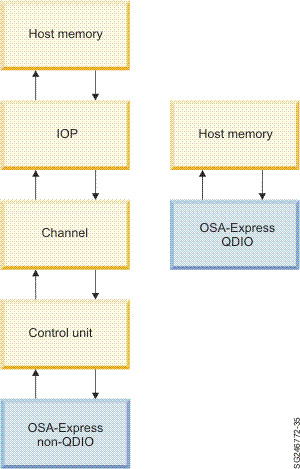QDIO is a highly efficient data transfer architecture, which dramatically
improves data transfer speed and efficiency for TCP/IP traffic.
QDIO mode is referred to as OSD because the CHPID type coded in the IOCDS
is OSD.
Figure 1 illustrates
the much shorter I/O process when in QDIO mode compared with non-QDIO mode
(the same I/O path as the OSA-2 features). Consequently, I/O interruptions
and I/O path-lengths are minimized.
The advantages of using QDIO mode are:
- A 20% improvement in performance versus non-QDIO mode
- The reduction of system assist processor (SAP) utilization
- Improved response time
- Server cycle reduction
How is this all accomplished? Instead of attaching an OSA-Express card
using a channel, and hence utilizing a channel or I/O program (IOP) combined
with CCW operations, the OSA-Express card attaches using an STI bus. STI stands
for Self-Timed Interface. The OSA-Express card is still connected within the
I/O cage, but the STI bus is directly connected to the memory bus of the CPC.
What is used instead of a CCW operation to signify that I/O needs to be
completed? With an OSA-Express card running in QDIO mode, I/O operations are
effected using a signal adapter instruction, or SIGA. The SIGA is still processed
by the SAP, similar to the way a CCW is processed by the SAP. However, the
SIGA effectively passes a pointer to the data because the data already occupies
internal storage.
This bus itself has a data speed of up to 2.7 GBps (gigabytes per second),
which is plenty of bandwidth to handle a 10 Gbps Ethernet LAN speed.
Figure 1. Non-QDIO versus QDIO data paths
QDIO incorporates a number of features:
- LPAR-to-LPAR communication
Access to an OSA-Express port can be shared
among the system images that are running in the LPARs to which the channel
path is defined to be shared. Also, access to a port can be shared concurrently
among TCP/IP stacks in the same LPAR, in different LPARs, or in different
logical channel subsystems. When port sharing, an OSA-Express port operating
in QDIO mode has the ability to send and receive IP traffic between LPARs
without sending the IP packets out to the LAN and then back to the destination
LPAR.
- DMA (direct memory access)
DMA allows data to move directly from the
OSA-Express microprocessor to the host memory. This bypasses three layers
of processing that are required when using ESCON and OSA-2 features, dramatically
improving throughput.
- Priority queuing
Priority queuing (for z/OS environments) sorts outgoing
IP message traffic according to the priority assigned in the IP header (using
the Type Of Service field). This priority is used to reflect the business
priorities assigned to the application, user ID, time of day, and other characteristics.
- Enhanced IP network availability
Enhanced IP network availability (IPA)
is a service of the QDIO architecture. When TCP/IP is started in QDIO mode,
it downloads all the home IP addresses in the stack and stores them in the
OSA-Express feature. The OSA-Express feature port then responds to ARP requests
for its own IP address, as well as for other IP addresses active in the TCP/IP
stack (in particular with virtual IP addresses (VIPA).
- VLAN support
IEEE standard
802.1Q describes the operation of virtual bridged LANs, known as VLANs. A
VLAN is defined to be a subset of the active topology of a LAN. The OSA-Express
features provide for the setting of multiple unique VLAN IDs per QDIO data
device. They also provide for both tagged and untagged frames to flow from
an OSA-Express port.
Full VLAN support is offered for all OSA-Express
Ethernet features available on mainframe servers. z/OS Communications Server
versions 1.5 and later support VLAN identifications (VLAN IDs).
Reminder: A VLAN frame looks almost the same as an Ethernet frame. The
difference is that a VLAN frame has a extra field containing a number that
identifies the VLAN. This number is called a VLAN tag.
|
- ARP Takeover
The
Address Resolution Protocol (ARP) Takeover provides the capability of switching
OSA-Express port operations from one OSA-Express to another OSA-Express running
in the same mode.
When TCP/IP is started in QDIO mode, it downloads
all the home IP addresses in the stack and stores them in each OSA-Express
feature to which it has a connection. This is a service of QDIO architecture
and occurs automatically only for OSD channels.
If an OSA-Express feature
fails while there is a backup OSA-Express available on the same network ID,
TCP/IP informs the backup OSA of which IP addresses (real and VIPA) to take
over, and the network connection is maintained. The takeover is effected by
something called a gratuitous ARP. A gratuitous ARP
is an unsolicited ARP response. All hosts on the LAN segment that receive
this gratuitous ARP will update their ARP cache with the new MAC address for
the backup OSA.
 Networking on z/OS
Networking on z/OS
 Networking on z/OS
Networking on z/OS
 Copyright IBM Corporation 1990, 2010
Copyright IBM Corporation 1990, 2010